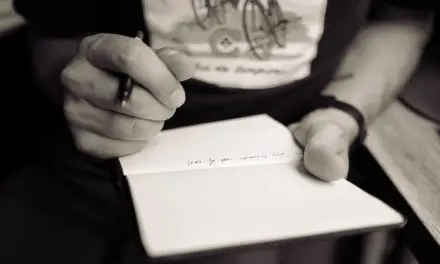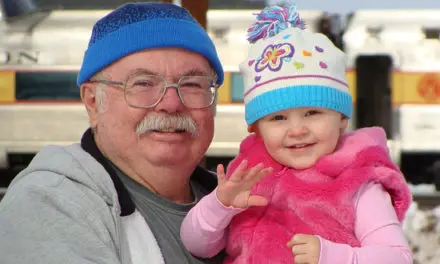by Jay Payleitner
Adapted from his book, Hooray for Grandparents!
The highly energized two-dimensional world of handheld tablets and big-screen TVs may seem to inspire creative thinking, but experts say it might be just the opposite. A multiyear study on adolescent brain cognitive development by the National Institutes of Health uncovered volumes of data and warnings regarding children’s increased exposure to digital screens.
Findings in the 2018 article “Is Screen Time Altering the Brains of Children?” in Healthline confirm that children who reported more than two hours a day of screen time got lower scores on thinking and language tests. Also, MRI scans found significant differences in the brains of children who reported using smartphones, tablets, and video games more than seven hours a day.
None of this should come as a surprise.
Saturday morning cartoons of the mid-twentieth century seem like still-life paintings compared to today’s fast-paced digital offerings for children. Plus, we grew up with one TV set that never left the family room instead of a hand-held device that begs for our grandchildren’s attention on every car trip, outing, appointment, queue, beach excursion, or visit to Grandma’s.
Admittedly, the images on those phones and tablets are the result of creativity by graphic digital designers. The images and audio may even be inspiring! But let’s also admit that the young people using those devices are not sharpening their imagination or developing any creative skills of their own.
That might be where grandparents can step up and step in. Busy and distracted parents may use screens as a babysitter or give up and give in to how older kids are using screens. But let’s make sure the time we spend with our grandkids is not wasted by allowing them to have their heads slumped over into that digital dungeon.
You can’t just scream, “Put down your darn phone!”
Which means the challenge is to come up with fascinating and compelling alternatives that will have your grandkids voluntarily holstering their screens to engage with something hands-on and legitimately creative.
My 7 ideas below might not be new to you, but feel free to add to this list. All you really need to do is think back to the stuff that fascinated you back in the day.
- Build stilts. If you’re a woodworker, you can imagine these already. Find or buy a couple of 6-foot (1.8 m) pieces of 1×2 pine for the poles. Attach triangles of wood for the footrests and watch your grade-school-age grandchild grow tall enough to look you in the eye.
- Invest in an art easel. For less than fifty bucks you can supply your grandchild with high-quality paint, brushes, paper, and an easel. The result is hours (and years) of creative play. And maybe a new hobby for you as well.
- Get creative with cookery. Let them page through one of your cookbooks. Find a recipe, do the shopping, and whip up a dish that neither of you has ever made before.
- Learn origami. It’s trickier than it looks. And some kids really, really get into it. Start with regular white printer paper and some online tutorials. Be prepared to invest in colored paper designed specifically for the purpose of elegant and imaginative paper folding.
- Start a family band. Gather harmonicas, kazoos, tambourines, maracas, recorders, and xylophones, one for each kid of any age, including grandparents.
- Make something temporary. On the beach, create a sandcastle. In the family room, build a fort with pillows, couch cushions, and blankets. (Use an upside-down laundry basket as a lookout turret.) Repurpose that giant cardboard appliance box into a castle, spaceship, or clubhouse. Cut out windows, doors, peepholes, and ramparts. Decorate with paints or markers. In a week, toss it in the recyclables.
- Build something that lasts. Make a treehouse, go-kart, dollhouse, game table, rocking horse, or skateboard ramp. Choose a project that may take more than a day to design and build. And really do it right.
Beyond these ideas, consider some of the mad skills you’ve developed (and maybe forgotten) over the years. Do you know how to juggle, whistle with your fingers, hang a spoon from your nose, draw caricatures, twist balloon animals, play the spoons, or do a few simple magic tricks? Pass it on!
For some of the above, you may have to do a Google or YouTube search for instructions. But other than that, power down any screen as quickly as possible.
Finally, we’d love to hear your success stories engaging in hands-on life with those young people you love so much. Just leave a comment on the Grandkids Matter Facebook page here.
Read more from Jay at Grandkids Matter here.

Jay Payleitner is a best-selling author of Hooray for Grandparents! and more than a dozen other books on marriage, family, and doing life right, including 52 Things Kids Need from a Dad, 52 Ways to Connect as a Couple, and What If God Wrote Your Bucket List? His weekly podcast is called, “Getting Life Right.” He and his wife, Rita, live near Chicago, where they’ve raised five great kids (and now have eight grandkids) and have loved on ten foster babies. For information on booking Jay to speak at your next event, visit jaypayleitner.com.






